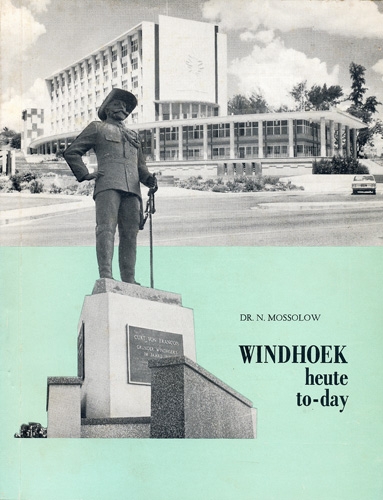The History of Namutoni, by Nikolai Mossolow
In order to write The History of Namutoni, Nikolai Mossolow interviewed several contemporary witnesses amgong the Schutztruppen personel who had been stationed at Fort Namutoni in South West Afrika.
Up to the outbreak of cattle plague in 1897 Namutoni remained a scarcely known spot on the map of South West Africa. To the Swedish traveller Charles John Andersson (1828-1867) goes the honour of having been the first white man known to have passed the watering place Omutjamatunda on his way to Ondongua accompanied by the Englishman Francis Galton (1822-1911). He describes a swampy spring on a hill surrounded by reeds, in which we recognise Namutoni. (Near Omutjamatunda the Ovambo people had built their first kraal.) The Rhenish Missionary, Carl Hugo Hahn (1818-1895), a Baltic German from the town of Riga, accompanied by the missionary Johannes Rath and the British-Canadian elephant hunter, Frederick Green (1829-1876) did not pass through Namutoni in 1857 on his way to the Ovamboland as has been assumed erroneously, but travelled past it further to the NE via Ondova. The Swiss botanist Hans Schinz (1858-1942), later Director of the Botanical Gardens in Zurich, who passed the watering place which he called Amutoni shortly after South West Africa had come under German colonial rule, devotes just one short sentence to it. It consisted of a large limestone basin, fed by a strong spring, surrounded by reeds which were inhabited by birds. He hunted and bathed there. Next came the trekboers who succumbed to Malaria fever on approaching Etosha.* At the outbreak of cattle plague a cordon, several hundred kilometres in length, was drawn across the northern part of the territory and Namutoni, on the crossroads between Otavi, Ondongua and the Omuramba Uovambo, became one of the outposts, just like Okaukuejo at the other end of Etosha. After the termination of the outbreak Namutoni remained a frontier post for the supervision of the trade with the Ovambo, especially with regard to the smuggling of firearms, ammunition and liquor. The garrison, consisting of a non-commissioned officer, a medical orderly and two troopers was housed in reed huts. In 1901 a military post was established at Okaukuejo under the command of Lieutenant Sixt of Arnim. A structure resembling a fortification with a round tower was erected, but fell into ruins long ago. [...]
* "Long before the "Dorstlandtrekkers" the following men visited Namutoni: the hunter and trader Smuts, the trader Charles Henry Sabatta, the poor white Robert Lewis, the Swede Axel Ericksson, the Baster William Worthington Jordan and the hunter and trader Pieter Botha" - My grateful acknowledgement to Mr. Johannes von Moltke for this information.
This is an extract from the book: The History of Namutoni, by Nikolai Mossolow.
Titlel: Die Verhaal van Namutoni - Die Geschichte von Namutoni - The History of Namutoni
Author: Nikolai Mossolow
Publisher: John Meinert (Pty) Ltd
Windhoek, South West Afrika 1971
Mossolow, Nikolai im Namibiana-Buchangebot
Otjikango or Gross Barmen
Otjikango or Gross Barmen: The history of the first Rhenish Herero Mission Station in Otjikango/Gross Barmen in South West Africa 1844-1904.
Hansheinrich von Wolf und Schloß Duwisib
Dies ist eine ortsgeschichtliche Schrift über Schloß Duwisib in Namibia und ihren Erbauer, Baron Hansheinrich von Wolf.
Waterberg. On the History of the Mission Station Otjozondjupa, the Kambazembi Tribe and Hereroland
This is a well documented, detailed and interesting book on the on the history of Waterberg, the Mission Station Otjozondjupa, the Kambazembi Tribe and what was then Hereroland.
Windhoek heute - Windhoek to-day
Windhoek heute - Windhoek to-day beschreibt die Haupstadt und das kulturelle Leben Südwestafrikas in der Zeit 60er Jahre.
Die Geschichte von Namutoni - Die Verhaal van Namutoni - The History of Namutoni
Die Verhaal van Namutoni - Die Geschichte von Namutoni - The History of Namutoni wurde von Dr. Nikolai Mossolow, der noch viele Zeitzeugen kennengelernt hatte, 1971 herausgegeben.
Windhoek damals; Die Windhoek van weleer; This was Old Windhoek
"Windhoek damals" beschreibt die Stadtgeschichte Windhoeks bis hin zur Aufhebung der deutschen Selbstverwaltung 1915.
Otjikango oder Gross Barmen
Ortsgeschichte der ersten Rheinischen Herero-Missionsstation Otjikango oder Gross Barmen in Südwestafrika 1844-1904.
Afrikanischer Heimatkalender 1983
Vom Afrikanischer Heimatkalender ist dieses Jahrbuch die Ausgabe von 1983.
Afrikanischer Heimatkalender 1981
Dies ist der 51. Jahrgang Afrikanischer Heimatkalender für das Jahr 1981.
Waterberg. Beitrag zur Geschichte der Missionsstation Otjozondjupa, des Kambazembi-Stammes und des Hererolandes
Beitrag zur Geschichte der Waterberg-Missionsstation Otjozondjupa, des Kambazembi-Stammes und des Hererolandes.











